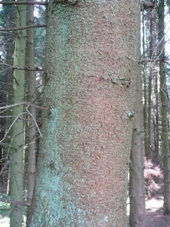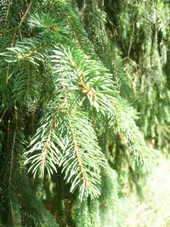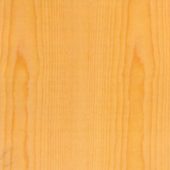Spruce (Picea abies)
Spruce: (Picea abies (L.)), pine/softwood from the Conifer family (Pinaceae).
Other names: Common Spruce, Norway Spruce, European Spruce.
Natural range
The spruce is one of most important commercially used trees in the northern hemisphere. It has an extremely wide natural range, covering extensive regions of Europe and far into eastern Asia. Most forestry operations are based on cultivated or artificially created pure stands, and so only very few natural forests are still being used. In central Europe, the common spruce is forestry’s “bread and butter” tree. In Germany alone, around 60% of all wood cut is spruce. As with other species, the decisive factors here are straight and fast growth, no great demands on their location and the wide range of uses for the wood.
Description of wood
Sap and heartwood are in distinguishable in colour (mature tree). The wood colour is yellowish-white and darkens under the influence of light (yellowish-brown). The colour transition within a year ring from the light whitish early wood to the reddish-yellow late wood is gradual. The clearly defined year ring edges provide the distinctive longitudinal stripes on the wood’s surface. When fresh, the wood is resinous. Spruce wood is soft and moderately heavy (basic density approx. 0.47 g/cm³ at 15 % wood moisture).
Workability
The workability of Spruce is very good. It holds nails well and is easy to saw, drill and plane. Can be dried easily both naturally and artificially, has no real tendency to warp or split and can be bonded without difficulty.
Durability
Spruce is only of low durability (durability class 4, acc. to EN 350-2), which means that, unprotected or untreated, it is not very resistant to the weather, but is quite resistant to acids and alkalis. You can find an overview of durability levels of the various wood species here.
Treatability
According to EN 350-2, mature spruce is classified as difficult to treat, while sapwood responds better. For ground contact applications, roundwood is recommended with an appropriate external sapwood casing that can be impregnated in a vacuum pressure process. You can find an overview of treatability levels of the various wood species here.
Application fields
Spruce is extremely versatile and can be used as roundwood, sawn timber, laminated timber or as veneer. As a material in building and civil engineering, as well as in interior design, spruce has a significant role to play. At the same time, it is the most important timber for the building materials industry and the production of paper and wood pulp. Externally, spruce is used in gardens and landscaping, for posts, utility poles, noise protection panels, bridges or even for cooling towers. The pre-condition for the long-term use of this low durability timber, especially for applications with ground or water contact, is preventive vacuum pressure treatment. High-grade spruce found in mountain regions are much coveted for the construction of musical instruments. Other uses include cabinetry and furniture construction, aircraft, boat and ship building.



